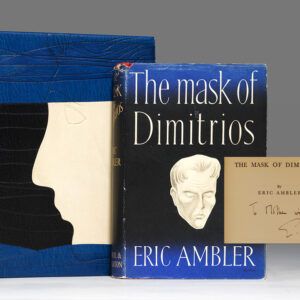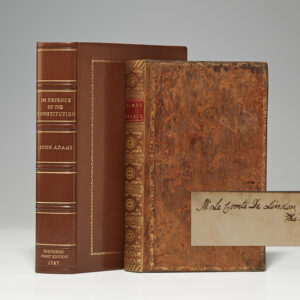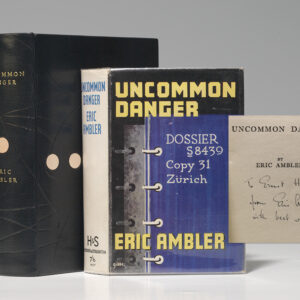Description
INSCRIBED BY JOHN ADAMS, AN EXCEEDINGLY RARE ASSOCIATION COPY OF MAYHEW’S DISCOURSE, A VITAL INFLUENCE ON REVOLUTIONARY PRINCIPLES, PRAISED BY ADAMS AS KEY TO “AN AWAKENING AND A REVIVAL OF AMERICAN PRINCIPLES”
(ADAMS, John) MAYHEW, Jonathan. A Discourse, Concerning Unlimited Submission and Non-Resistance to the Higher Powers; With Some Reflections on the Resistance Made to King Charles I. Boston, 1818. Octavo, original self-wrappers, stitched as issued.
Second edition of Mayhew’s Discourse, “the most famous sermon preached in pre-Revolutionary America” and highly praised by John Adams for igniting “universal alarm against the authority of Parliament,” this extremely rare association copy inscribed on the title page by Adams in the same year as this printing, “Presented to Miss E[liza] S[usan] Quincy, Nov. 16th 1818, by John Adams.” Scarce, in original wrappers.
Boston minister “Jonathan Mayhew was from the beginning of his career a radical, an agitator, a dominating figure… regarded by the Otises and the Adamses as a prophet of the revolution” (Miller, Puritans, 277). “In 1750 Mayhew sought to work out, in his celebrated Discourse Concerning Unlimited Submission, a full rationale for resistance to constituted government” (Bailyn, Ideological Origins, 52). In this Discourse, “the most famous sermon preached in pre-Revolutionary America… one may see a gathering of threads that reach back into the earliest periods of American history and that extend forward into the constitutional debates of the 1760s and 1770s, and beyond that, into the construction of new governments in the American Republic” (Bailyn, Pamphlets, 204-11). While in his 20s, John Adams was present when Mayhew delivered this “famous attack on the doctrine of the divine right of kings, which Mayhew called ‘altogether as fabulous and chimerical as transubstantiation” (Brookhiser, 16). “It was to this Discourse… that Adams later referred those ‘who really wish to investigate the principles and feelings which produced the Revolution.’ The purpose of Mayhew’s Discourse… preached on the anniversary of the death of Charles I… [argues] that the people have the right and duty to resist bad rulers… It is Mayhew’s discussion of the right and duty to resist in the name of liberty that Adams found to be so descriptive of the principles and feelings that produced the Revolution” (Webking, 156-9).
In his much cited letter to the editor of Baltimore’s Weekly Register, written the same year as publication of this edition of Mayhew’s Discourse and the date of his inscription, Adams further hailed Mayhew—along with Hancock and Samuel Adams—as chief among those few who “produced, in 1760 and 1761, an awakening and a revival of American principles and feelings, with an enthusiasm which went on increasing till, in 1775, it burst out in open violence, hostility and fury.” Continuing, Adams noted that Mayhew’s “sermon in 1750, on the 30th of January, on the subject of passive obedience and non-resistance… [was] seasoned with wit and satire superior to any in Swift and Franklin. It was read by everybody; celebrated by friends and abused by enemies.” Adams also praised Mayhew for his ability “to revive [Americans’] animosities against tyranny, in church and state, and at the same time to destroy their bigotry, fanaticism and inconsistency… To draw the character of Mayhew, would be to transcribe a dozen volumes. This transcendent genius threw all the weight of his great fame into the scale of his country… and maintained it there with zeal and ardor till his death” (“Letter to Hezekiah Niles,” February 13, 1818). Mayhew’s Discourse was ultimately central to inspiring an American impulse for liberty by boldly asserting, “that resistance to tyranny is obedience to God, as well in Church as in State” (Sabin 47131). With preface by Mayhew. Evans 6549. Shaw & Shoemaker 44770. Sabin 47131. See Eberstadt 115:33; Sabin 47148. A exceedingly rare association copy, presented by Adams within a decade of his death to artist Eliza Susan Quincy, daughter of Josiah Quincy, president of Harvard, a mayor of Boston and Abigail Adams’ third cousin. Eliza Quincy wrote of accompanying Adams two weeks after Abigail’s death in October 1818 to view Trumbull’s “enormous new painting of the signing of the Declaration,” then at Boston’s Faneuil Hall. In her diary she wrote that “the aged Adams standing before the painting, gazing silently at ‘the great scene in which he had borne a conspicuous place’ was a sight long remembered” (McCullough, John Adams, 626). The November 16, 1818 date of Adams’ inscription to her comes within weeks of that visit. With a lightly penciled line from the title page imprint to an owner inscription stating “In Mr. Nelson’s poss—65 yrs.” Very light scattered foxing, minimal edge-wear. A near-fine association copy with an especially memorable inscription.



